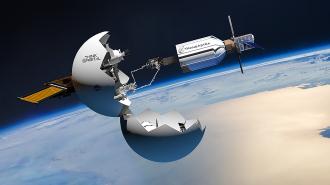NASA is paying aerospace startup TransAstra $850,000 to build an inflatable bag for capturing space trash — and the company already has a clever idea for what to do with the junk it collects.
The challenge: Humans have sent a lot of stuff up into space since the first Sputnik, and not all of it has come back down. As a result, Earth’s orbit is now cluttered with millions of useless objects: defunct satellites, rocket parts, and other space trash.
The increased accessibility of space means the amount of orbital debris could soon increase substantially.
These objects are moving so fast that a collision with something as small as a rogue screw could slice through a satellite, disrupting communications systems here on Earth. Worse yet, it could punch a hole in a spacecraft carrying people.
With smaller, cheaper satellites and reusable rockets making space more accessible than ever, the amount of orbital debris could increase substantially in the near future, too.
What’s new? To avoid space turning into a junkyard too dangerous for anyone to explore, NASA and other space agencies are on the hunt for ways to clean up space junk.
NASA awarded TransAstra a $150,000 contract in its Small Business Innovation Research Ignite program to develop a space trash removal system called the “Mini Bee Capture Bag,” which it originally designed for capturing small asteroids.
The concept has now moved on to phase 2, earning TransAstra an additional $850,000 to build a prototype and demonstrate on the ground how it could snatch a piece of space junk.
How it works: TransAstra’s vision is to send the bag into space along with one of its Worker Bee spacecraft, which it’s developing primarily to deploy small satellites.
Once the Worker Bee is in the same orbit as a piece of space trash, it could slow slightly, the bag would inflate, and the junk would travel right into the bag. The bag could then close, enveloping the object so that it could be carried away.
This approach is much simpler than concepts that involve latching on to a piece of space junk, according to Joel Sercel, TransAstra’s founder and CEO.
“It doesn’t require the target to have any fixture that you can grab onto,” he told SpaceNews. “It does not require docking, which is a precision maneuver. You have to be precise enough to open the bag, get the bag around this thing, and close the bag.”
Waste not: After collecting multiple pieces of space trash, TransAstra envisions the Worker Bee heading to an uncrewed space station being developed by another space startup, ThinkOrbital. There, robots could service or repurpose the space junk, and the Worker Bee could refuel.
“Recycling stations in space … transform what was previously a liability into an asset.”
Nicole Shumaker
According to a joint study by the two companies, capturing, storing, and reusing space junk in this way would cut the time needed to remove debris by 40% and be 6 times cheaper than launching individual pieces into Earth’s atmosphere to burn up.
“Repeated trips to pick up orbital debris and transport it to Earth’s atmosphere for disposal require significant propellant and time,” Nicole Shumaker, TransAstra’s VP of strategic partnerships, said in a statement shared with SpaceNews.
“Recycling stations in space resolve this problem and transform what was previously a liability into an asset that not only mitigates orbital debris but opens up new possibilities for in-space manufacturing and construction,” she continued.
Looking ahead: This phase of the program will last a maximum of 2 years, and if TransAstra can successfully demonstrate the bag here on Earth during that time, it could move on to phase 3 of the program.
That phase will focus on commercializing the capture bag so that NASA and others can hire TransAstra to be their off-world trash collectors, cleaning up the mess we’ve made of Earth’s orbit.
We’d love to hear from you! If you have a comment about this article or if you have a tip for a future Freethink story, please email us at tips@freethink.com.
